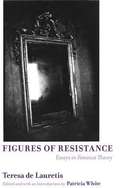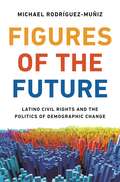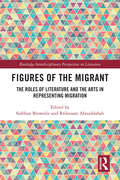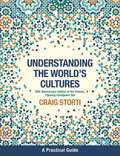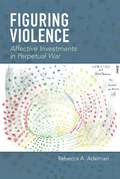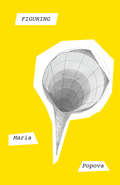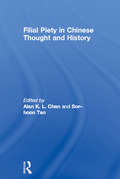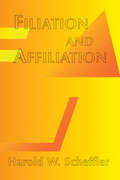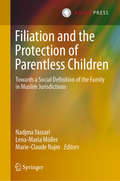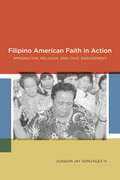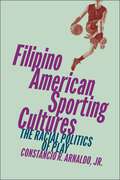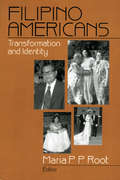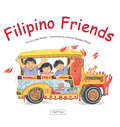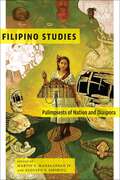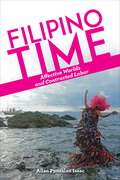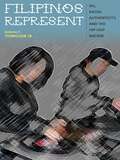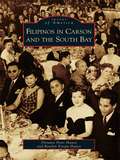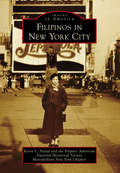- Table View
- List View
Figures of Resistance: Essays in Feminist Theory
by Patricia White Teresa De LauretisThe changing face of feminist discourse as reflected by the career of one of its preeminent scholars Figures of Resistance brings together the unpublished lectures and little-seen essays of internationally renowned theorist Teresa de Lauretis, spanning over twenty years of her finest work. Thirty years after the height of feminist theory, this collection invites us to reflect on the history of feminism and take a hard look at where it stands today. Selected essays include "Sexual Indifference and Lesbian Representation," "The Lure of the Mannish Lesbian," "Eccentric Subjects," "Habit Changes," "The Intractability of Desire," and the unpublished article "Figures of Resistance." An introduction from feminist film scholar Patricia White provides an overview of the development of de Lauretis's thought and of feminist theory over past decades.
Figures of the Future: Latino Civil Rights and the Politics of Demographic Change
by Michael Rodríguez-MuñizAn in-depth look at how U.S. Latino advocacy groups are using ethnoracial demographic projections to bring about political change in the presentFor years, newspaper headlines, partisan speeches, academic research, and even comedy routines have communicated that the United States is undergoing a profound demographic transformation—one that will purportedly change the “face” of the country in a matter of decades. But the so-called browning of America, sociologist Michael Rodríguez-Muñiz contends, has less to do with the complexion of growing populations than with past and present struggles shaping how demographic trends are popularly imagined and experienced. Offering an original and timely window into these struggles, Figures of the Future explores the population politics of national Latino civil rights groups.Based on eight years of ethnographic and qualitative research, spanning both the Obama and Trump administrations, this book investigates how several of the most prominent of these organizations—including UnidosUS (formerly NCLR), the League of United Latin American Citizens, and Voto Latino—have mobilized demographic data about the Latino population in dogged pursuit of political recognition and influence. In census promotions, get-out-the-vote campaigns, and policy advocacy, this knowledge has been infused with meaning, variously serving as future-oriented sources of inspiration, emblems for identification, and weapons for contestation. At the same time, Rodríguez-Muñiz considers why these political actors have struggled to translate this demographic growth into tangible political gain and how concerns about white backlash have affected how they forecast demographic futures.Figures of the Future looks closely at the politics surrounding ethnoracial demographic changes and their rising influence in U.S. public debate and discourse.
Figures of the Migrant: The Roles of Literature and the Arts in Representing Migration (Routledge Interdisciplinary Perspectives on Literature)
by Siobhan Brownlie and Rédouane AbouddahabThis volume seeks to investigate the representation of the migrant and migration in literary texts and the arts. Through studies that examine works in a range of art forms ‒ novels, theatre, poetry, creative non-fiction, documentary films, and performance and video installations ‒ that evoke a variety of historical and (trans)national contexts, the volume focuses on the question of the roles of literature and the arts in representing migration. An important issue considered is the extent to which artistic figuration can act as a counterpoint to social discourse on migrants that often involves stereotypes and reductive views. The different contributions to the volume illustrate that literature and the arts can provide readers and viewers with a space for fluid knowledge production and affective expansion, and that within that overarching function, artistic works play three main roles with regard to representing migration: undertaking a socio-political and cultural critique, presenting alternative views to stereotypes that highlight the singularity and complexity of the migrant, and providing proposals for different futures.
Figuring Foreigners Out: A Practical Guide
by Craig StortiHere is the ultimate, self-instructional cross-cultural training manual. Craig Storti, author of The Art of Crossing Cultures, The Art of Coming Home, Incident at Bitter Creek and Cross-Cultural Dialogues, brings his wealth of knowledge and his creative mind to this exceptional new resource. Figuring Foreigners Out is designed for anyone who wants to help in "figuring out" the behavior of someone from another culture. Educators, trainers and individuals will profit from this user-friendly workbook. readers can work through exercises which are vintage Storti-- on their own or in a training group. Concepts at the heart of intercultural communication are addressed in a step-by-step manner and include individualism and collectivism, monochronic and polychronic concepts of time, verbal and nonverbal communication styles and power distance relationships in the workplace. Storti uses cross-cultural dialogues as a sort of pre- and post-test for many of the ideas he introduces--inviting readers to return to them after completing the exercises to analyze them in light of what they have learned. Storti ends with a definition of four stages of cultural awareness--unconcious incompetence, concious incompetence, concious competence and unconcious competence--and invites readers to assess their level of awareness after working through the activities. Readers will find themselves better able to incorporate new attitudes and behaviors into their dealings with people who view the world from a different perspective. Throughout, Storti uses literary quotations to enrich his text. This is one of the few books that individuals can work through and, without the aid of a structured training program, effectively prepare themselves for dealing with cultural differences they encounter. Yet it is also ideal as a training text. It should be high-priority reading for anyone who may come into contact with people from foreign cultures whether overseas (corporate expatriates, study abroad participants, volunteers, missionaries, military personnel) or at home in multicultural settings (the workplace, school and other social or organizational contexts). Perhaps the most remarkable aspect of this book is its universality--it is neither overtly nor implicitly oriented to one culture and therefore can be used by anyone interested in understanding people who are culturally different from themselves.
Figuring Resistance: The Revolution in Film and Literature in the Philippines (Contestations in Contemporary Southeast Asia)
by Laurence Marvin CastilloThis book examines how fiction films and novels represent the communist-led national democratic (NatDem) revolution in the Philippines. Produced aboveground decades after the Philippines’ historic transition from dictatorship to elite democracy, these NatDem fictions depict how the communist movement in the Philippines confronted various national and global changes, tracking revolutionary experiences amidst the ascendancy of neoliberalism, the continuation of counterinsurgency and the emergence of non-Marxist social movements and discourses. Figuring Resistance studies how fictions portray the tenacity of political commitment among revolutionaries engaged in the revolution's manifold history of crises, setbacks, and persistence. It illuminates the crucial role played by cultural work in creating and nourishing an oppositional public sphere, where the experiential makings of the liberation struggle in the Third World can be imagined.
Figuring Victims in International Criminal Justice: The case of the Khmer Rouge Tribunal
by Maria ElanderMost discourses on victims in international criminal justice take the subject of victims for granted, as an identity and category existing exogenously to the judicial process. This book takes a different approach. Through a close reading of the institutional practices of one particular court, it demonstrates how court practices produce the subjectivity of the victim, a subjectivity that is profoundly of law and endogenous to the enterprise of international criminal justice. Furthermore, by situating these figurations within the larger aspirations of the court, the book shows how victims have come to constitute and represent the link between international criminal law and the enterprise of transitional justice. The book takes as its primary example the Extraordinary Chambers in the Courts of Cambodia (ECCC), or the Khmer Rouge Tribunal as it is also called. Focusing on the representation of victims in crimes against humanity, victim participation and photographic images, the book engages with a range of debates and scholarship in law, feminist theory and cultural legal theory. Furthermore, by paying attention to a broader range of institutional practices, Figuring Victims makes an innovative scholarly contribution to the debates on the roles and purposes of international criminal justice.
Figuring Violence: Affective Investments in Perpetual War
by Rebecca A. AdelmanIn the United States, the early years of the war on terror were marked by the primacy of affects like fear and insecurity. These aligned neatly with the state’s drive toward intensive securitization and an aggressive foreign policy. But for the broader citizenry, such affects were tolerable at best and unbearable at worst; they were not sustainable. Figuring Violence catalogs the affects that define the latter stages of this war and the imaginative work that underpins them. These affects—apprehension, affection, admiration, gratitude, pity, and righteous anger—are far more subtle and durable than their predecessors, rendering them deeply compatible with the ambitions of a state embroiling itself in a perpetual and unwinnable war.Surveying the cultural landscape of this sprawling conflict, Figuring Violence reveals the varied mechanisms by which these affects have been militarized. Rebecca Adelman tracks their convergences around six types of beings: civilian children, military children, military spouses, veterans with PTSD and TBI, Guantánamo detainees, and military dogs. All of these groups have become preferred objects of sentiment in wartime public culture, but they also have in common their status as political subjects who are partially or fully unknowable. They become visible to outsiders through a range of mediated and imaginative practices that are ostensibly motivated by concern or compassion. However, these practices actually function to reduce these beings to abstracted figures, silencing their political subjectivities and obscuring their suffering. As a result, they are erased and rendered hypervisible at once. Figuring Violence demonstrates that this dynamic ultimately propagates the very militarism that begets their victimization.
Figuring: Fortune Favours The Fast
by Maria PopovaFiguring explores the complexities of love and the human search for truth and meaning through the interconnected lives of several historical figures across four centuries—beginning with the astronomer Johannes Kepler, who discovered the laws of planetary motion, and ending with the marine biologist and author Rachel Carson, who catalyzed the environmental movement. <P><P>Stretching between these figures is a cast of artists, writers, and scientists—mostly women, mostly queer—whose public contribution have risen out of their unclassifiable and often heartbreaking private relationships to change the way we understand, experience, and appreciate the universe. Among them are the astronomer Maria Mitchell, who paved the way for women in science; the sculptor Harriet Hosmer, who did the same in art; the journalist and literary critic Margaret Fuller, who sparked the feminist movement; and the poet Emily Dickinson. <P><P>Emanating from these lives are larger questions about the measure of a good life and what it means to leave a lasting mark of betterment on an imperfect world: Are achievement and acclaim enough for happiness? Is genius? Is love? <P><P>Weaving through the narrative is a set of peripheral figures—Ralph Waldo Emerson, Charles Darwin, Elizabeth Barrett Browning, Herman Melville, Frederick Douglass, Nathaniel Hawthorne, and Walt Whitman—and a tapestry of themes spanning music, feminism, the history of science, the rise and decline of religion, and how the intersection of astronomy, poetry, and Transcendentalist philosophy fomented the environmental movement. <P><b>A New York Times Bestseller</b>
Fiji My Island Home: Country village life including Sugar Cane Farmers - Fiji
by Dr Kamlesh SharmaFiji: my island home provides an extraordinary insight in the daily livelihood of the poor sugar cane farmers in Fiji. The book discloses the struggles, survival and contributions to the local economy by farmers who toil on small pieces of land ranging in sizes of three to five acres each. These are leased from the Indigenous owners for a fixed term with no provision for further extension. The public bus services in Fiji are vividly narrated to capture the true essence of the word 'Fiji Time'. The book tries to build bridges of remembrance, understanding and reconciliation amongst Fijians of diverse cultural backgrounds. Finally, the book very clearly articulates and communicates the message that no matter where a Fijian is located in the world, one can never part from the fond memories of the island home!
Filial Piety in Chinese Thought and History
by Sor-Hoon Tan Alan ChanThe phenomenon of filial piety is fundamental to our understanding of Chinese culture, and this excellent collection of essays explores its role in various areas of life throughout history. Often regarded as the key to preserving Chinese tradition and identity, its potentially vast impact on government and the development of Chinese culture makes it extremely relevant, and although invariably virtuous in its promotion of social cohesion, its ideas are often controversial. A broad range of topics are discussed chronologically including Confucianism, Buddhism and Daoism, making it essential reading for those studying Chinese culture, religion and philosophy. This is a multi-disciplinary survey that combines historical studies with philosophical analysis from an international team of respected contributors.
Filiation And Affiliation
by Harold SchefflerFirst Published in 2018. Routledge is an imprint of Taylor & Francis, an Informa company.
Filiation and the Protection of Parentless Children: Towards a Social Definition of the Family in Muslim Jurisdictions
by Nadjma Yassari Lena-Maria Möller Marie-Claude NajmThis book contains selected contributions presented during the workshop “Establishing Filiation: Towards a Social Definition of the Family in Islamic and Middle Eastern Law?”, which was convened in Beirut, Lebanon in November 2017.Filiation is a multifaceted concept in Muslim jurisdictions. Beyond its legal aspect, it encompasses the notion of inclusion and belonging, thereby holding significant social implications. Being the child of someone, carrying one’s father’s name, and inheriting from both parents form important pillars of personal identity.This volume explores filiation (nasab) and alternative forms of a full parent-child relationship in Muslim jurisdictions. Eleven country reports ranging from Morocco to Malaysia examine how maternal and paternal filiation is established – be it by operation of the law, by the parties’ exercise of autonomy, such as acknowledgement, or by scientific means, DNA testing in particular – and how lawmakers, courts, and society at large view and treat children who fall outside those legal structures, especially children born out of wedlock or under dubious circumstances. In a second step, alternative care schemes in place for the protection of parentless children are examined and their potential to recreate a legal parent-child relationship is discussed.In addition to the countr y-specific analyses included in this book, three further contributions explore the subject matter from perspectives of premodern Sunni legal doctrine, premodern Shiite legal doctrine and the private international law regimes of contemporary Arab countries. Finally, a comparative analysis of the themes explored is presented in the synopsis at the end of this volume.The book is aimed at scholars in the fields of Muslim family law and comparative family law and is of high practical relevance to legal practitioners working in the area of international child law.Nadjma Yassari is Leader of the Research Group “Changes in God’s Law: An Inner-Islamic Comparison of Family and Succession Law” at the Max Planck Institute for Comparative and International Private Law while Lena-Maria Möller is a Senior Research Fellow at the Max Planck Institute and a member of the same Research Group. Marie-Claude Najm is a Professor in the Faculty of Law and Political Science at Saint Joseph University of Beirut in Lebanon and Director of the Centre of Legal Studies and Research for the Arab World (CEDROMA).
Filipino American Faith in Action: Immigration, Religion, and Civic Engagement
by Joaquin Jay GonzalezFilipinos are now the second largest Asian American immigrant group in the United States, with a population larger than Japanese Americans and Korean Americans combined. Surprisingly, there is little published on Filipino Americans and their religion, or the ways in which their religious traditions may influence the broader culture in which they are becoming established.Filipino American Faith in Action draws on interviews, survey data, and participant observation to shed light on this large immigrant community. It explores Filipino American religious institutions as essential locations for empowerment and civic engagement, illuminating how Filipino spiritual experiences can offer a lens for viewing this migrant community’s social, political, economic, and cultural integration into American life. Gonzalez examines Filipino American church involvement and religious practices in the San Francisco Bay Area and in the Phillipines, showing how Filipino Americans maintain community and ethnic and religious networks, contra assimilation theory, and how they go about sharing their traditions with the larger society.
Filipino American Sporting Cultures: The Racial Politics of Play
by Constancio R. Jr.Examines the significance of sports in the lives of diasporic Filipino AmericansOrganized sports have occupied a central place in Filipino American life since US colonialism began in the Philippines in 1898. For Filipino diasporas in the United States, sports are important cultural sites through which men and women cultivate a sense of ethnic community and belonging to the American national fabric.Sports studies focused on Asian America have tended to focus on East Asians, largely ignoring Filipinos. Thus, we know very little about how sports work as critical arenas to understand larger questions about Filipino identity formations, racialization, gender dynamics, diasporic contours, and post-colonial sporting cultures. This book offers an in-depth ethnographic examination of the significance of sports to the lives of Filipino Americans under the shadow of US empire and neocolonial inequities. Through a close examination of Filipino American sportingcultures—from boxing and the Manny “Pac-Man” Pacquiao phenomenon to men’s basketball leagues to women’s flag football—this book shows how engagements with sports reveal the shifting nature of Filipino Americanness and Filipino American subjectivity.Drawing on over four years of data collected in Southern California, Las Vegas, Urbana-Champaign, and Arlington, Constancio R. Arnaldo, Jr. documents the intimate connections among Filipino American sports, transnationalism, and diasporic belonging. Filipino American Sporting Cultures adds an important voice to the body of work using sports as a lens to look at US culture and communities of color.
Filipino Americans: Transformation and Identity
by Dr Maria P. RootWhen Asian Americans are discussed in the media the reference is often to people of Chinese or Japanese descent. However, the largest Asian American ethnic group is Filipino, a group of which little is known or written despite its long-standing history with the United States. This interdisciplinary analysis rectifies this dearth of information by addressing ethnic identity, the impact of different colonizations on ethnic identity, personal and family relationships, mental health, race, and racism. In addition, the sociopolitical context is examined in each chapter, making the volume useful as a foundational tool for hypothesis generation, empirical research, policy analysis and planning, and literature review.
Filipino Celebrations
by Liana Romulo Corazon Dandan-AlbanoBrimming with vivid illustrations and rich cultural background, Filipino Celebrations brings to life the festivals and celebrations of this diverse island nation. Each chapter discusses the history of the holiday; its cultural influences; how certain holidays are celebrated differently in different regions of the Philippines; special customs, foods, key words and phrases associated with the festivals; and more.Perfect for families looking to share the unique culture of the Philippines and educators interested in promoting multiculturalism in the classroom, Filipino Celebrations includes activities such as games, songs, crafts and recipes which encourage children to participate and learn while having fun.
Filipino Celebrations
by Liana Romulo Corazon Dandan-AlbanoBrimming with vivid illustrations and rich cultural background, Filipino Celebrations brings to life the festivals and celebrations of this diverse island nation. Each chapter discusses the history of the holiday; its cultural influences; how certain holidays are celebrated differently in different regions of the Philippines; special customs, foods, key words and phrases associated with the festivals; and more.Perfect for families looking to share the unique culture of the Philippines and educators interested in promoting multiculturalism in the classroom, Filipino Celebrations includes activities such as games, songs, crafts and recipes which encourage children to participate and learn while having fun.
Filipino Friends
by Liana Romulo Corazon Dandan-AlbanoThrough the eyes of Sam, a Filipino-American boy visiting the Philippines for the very first time, children will learn about Philippine customs and language. Soft, whimsical watercolors labeled with English words and Filipino translations bring to light the differences between Western and Philippine lifestyles. Children of expatriate Filipinos as well as expatriate children living in the Philippines will find Filipino Friends indispensable in bridging the gap between the two cultures.
Filipino Friends
by Liana Romulo Corazon Dandan-AlbanoThrough the eyes of Sam, a Filipino-American boy visiting the Philippines for the very first time, children will learn about Philippine customs and language. Soft, whimsical watercolors labeled with English words and Filipino translations bring to light the differences between Western and Philippine lifestyles. Children of expatriate Filipinos as well as expatriate children living in the Philippines will find Filipino Friends indispensable in bridging the gap between the two cultures.
Filipino Studies: Palimpsests of Nation and Diaspora
by Martin F. ManalansanAfter years of occupying a vexed position in the American academy, Philippine studies has come into its own, emerging as a trenchant and dynamic space of inquiry. Filipino Studies is a field-defining collection of vibrant voices, critical perspectives, and provocative ideas about the cultural, political, and economic state of the Philippines and its diaspora. Traversing issues of colonialism, neoliberalism, globalization, and nationalism, this volume examines not only the past and present position of the Philippines and its people, but also advances new frameworks for re-conceptualizing this growing field. Written by a prestigious lineup of international scholars grappling with the legacies of colonialism and imperial power, the essays examine both the genealogy of the Philippines’ hyphenated identity as well as the future trajectory of the field. Hailing from multiple disciplines in the humanities and social sciences, the contributors revisit and contest traditional renditions of Philippine colonial histories, from racial formations and the Japanese occupation to the Cold War and “independence” from the United States. Whether addressing the contested memories of World War II, the “voyage” of Filipino men and women into the U.S. metropole, or migrant labor and the notion of home, the assembled essays tease out the links between the past and present, with a hopeful longing for various futures. Filipino Studies makes bold declarations about the productive frameworks that open up new archives and innovative landscapes of knowledge for Filipino and Filipino American Studies.
Filipino Time: Affective Worlds and Contracted Labor
by Allan Punzalan IsaacFrom spectacular deaths in a drag musical to competing futures in a call center, Filipino Time examines how contracted service labor performed by Filipinos in the Philippines, Europe, the Middle East, and the United States generates vital affects, multiple networks, and other lifeworlds as much as it disrupts and dislocates human relations. Affective labor and time are re-articulated in a capacious archive of storytelling about the Filipino labor diaspora in fiction, musical performance, ethnography, and documentary film. Exploring these cultural practices, Filipino Time traces other ways of sensing, making sense of, and feeling time with others, by weaving narratives of place and belonging out of the hostile but habitable textures of labortime. Migrant subjects harness time and the imagination in their creative, life making capacities to make communal worlds out of one steeped in the temporalities and logics of capital.
Filipinos Represent: DJs, Racial Authenticity, and the Hip-hop Nation
by Antonio T. Tiongson Jr.The &“Hip-hop Nation&” has been scouted, staked out, and settled by journalists and scholars alike. Antonio T. Tiongson Jr. steps into this well-mapped territory with questions aimed at interrogating how nation is conceptualized within the context of hip-hop. What happens, Tiongson asks, to notions of authenticity based on hip-hop&’s apparent blackness when Filipino youth make hip-hop their own? Tiongson draws on interviews with Bay Area–based Filipino American DJs to explore the authenticating strategies they rely on to carve out a niche within DJ culture. He shows how Filipino American youth involvement in DJing reconfigures the normal boundaries of Filipinoness predicated on nostalgia and cultural links with an idealized homeland. Filipinos Represent makes the case that while the engagement of Filipino youth with DJ culture speaks to the broadening racial scope of hip-hop—and of what it means to be Filipino—such involvement is also problematic in that it upholds deracialized accounts of hip-hop and renders difference benign. Looking at the ways in which Filipino DJs legitimize their place in an expressive form historically associated with African Americans, Tiongson examines what these complex forms of identification reveal about the contours and trajectory of contemporary U.S. racial formations and discourses in the post–civil rights era.
Filipinos in Canada
by Bonnie Mcelhinny John Paul Catungal Lisa M. Davidson Ethel Tungohan Roland Sintos ColomaThe Philippines became Canada's largest source of short- and long-term migrants in 2010, surpassing China and India, both of which are more than ten times larger. The fourth-largest racialized minority group in the country, the Filipino community is frequently understood by such figures as the victimized nanny, the selfless nurse, and the gangster youth. On one hand, these narratives concentrate attention, in narrow and stereotypical ways, on critical issues. On the other, they render other problems facing Filipino communities invisible.This landmark book, the first wide-ranging edited collection on Filipinos in Canada, explores gender, migration and labour, youth spaces and subjectivities, representation and community resistance to certain representations. Looking at these from the vantage points of anthropology, cultural studies, education, geography, history, information science, literature, political science, sociology, and women and gender studies, Filipinos in Canada provides a strong foundation for future work in this area.
Filipinos in Carson and the South Bay (Images of America)
by Florante Peter Ibanez Roselyn Estepa IbanezOne of Carson's most distinct features is its diversity. The city is roughly one-quarter each Hispanic, African American, white, and Asian/ Pacific Islander. This last group's vast majority are Filipinos who settled as early as the 1920s as farmworkers, U.S. military recruits, entrepreneurs, medical professionals, and other laborers, filling the economic needs of the Los Angeles region. This vibrant community hosts fiestas like the Festival of Philippine Arts and Culture and has produced local community heroes, including "Uncle Roy" Morales and "Auntie Helen" Summers Brown. Filipino students of the 1970s organized to gain college admissions, establish ethnic studies, and foster civic leadership, while Filipino businesses have flourished in Carson, San Pedro, Wilmington, Long Beach, and the surrounding communities. Carson is recognized nationally as a Filipino American destination for families and businesses, very much connected to the island homeland.
Filipinos in New York City
by Kevin L. Nadal Filipino-American National Historical SocietyAfter the Spanish-American War in 1898, many Filipinos immigrated to New York City, mostly as students, enrolling at local institutions like Columbia University and New York University. Some arrived via Ellis Island as early as 1915, while Filipino military servicemen and Navy seafarers settled in New York after both World Wars I and II. After the Asian Immigration Act of 1965, many Filipinos came as professionals (e.g., nurses, physicians, and engineers) and formed settlements in various ethnic enclaves throughout the five boroughs of New York. Over the years, Filipinos have contributed significantly to New York arts and culture through Broadway theater, fashion, music, film, comedy, hip-hop, poetry, and dance. Filipino New Yorkers have also been successful entrepreneurs, corporate executives, community leaders, and politicians, and some, sadly, were victims of the 9/11 World Trade Center attacks.
